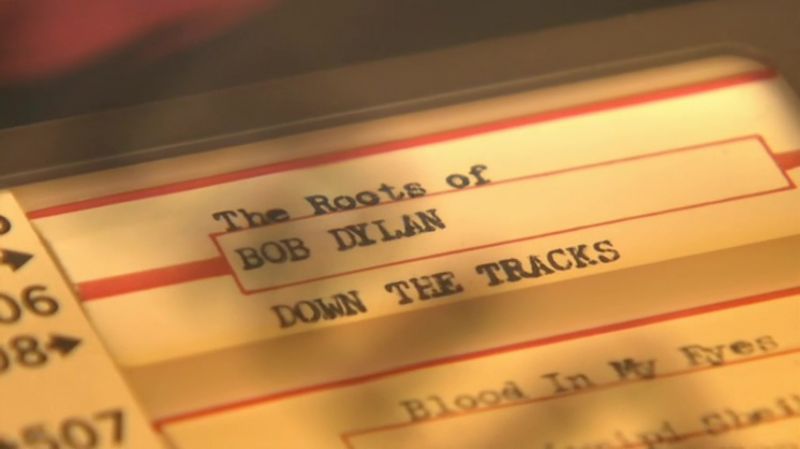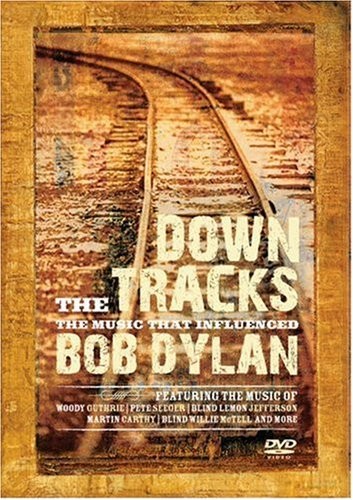
Down The Tracks: Bob Dylan and the Music That Influenced Him (documentary)
Just as Bob Dylan has inspired four decades of musicians, so too was his own musical style influenced by those who came before him. This documentary profiles the folk performers who had the greatest impact on Dylan’s early career. Leadbelly, Pete Seeger, Mississippi John Hurt and other musicians appear in vintage clips, while special focus is given to Woody Guthrie, whose bond with Dylan is reflected in nearly all of Dylan’s music.

While there isn’t a note of Bob Dylan singing in this documentary from 2008, it is still a very worthwhile watch. It gives us a depiction of what influenced Bob Dylan as he grew into the greatest songwriter of all time. There are great and rare clips of Pete Seeger, Leadbelly and many more.
A very interesting addition to all the films about Dylan and the music that influenced (and still influences) him.
Here is a fine Review from Alfred Johnson, posted on Amazon:
“Okay, okay I have gone on and one over the past year or so about the influence of Bob Dylan’s music (and lyrics) on me, and on my generation, the Generation of ’68. But, please, don’t blame me. Blame Bob. After all he could very easily have gone into retirement and enjoyed the fallout from his youthful fame and impressed one and all at his local AARP chapter. But, no, he had to go out on the road continuously, seemingly forever, keeping his name and music front and center. Moreover, the son of a gun has done more reinventions of himself than one could shake a stick at (folk troubadour, symbolic poet in the manner of Rimbaud and Verlaine, heavy metal rocker, blues man, etc.) So, WE are left with forty or so years of work to go through to try to sort it out. In short, can I (or anyone else) help it if he is restless and acts, well, like a rolling stone?
All of this is by way of introduction to a recent (2008) very worthwhile addition to the immense commentary on Bob Dylan’s work, “Down The Tracks: The Music That Influenced Bob Dylan”. Those influences form the stated central premise of this little documentary, filled with many, many knowledgeable “talking heads” that have, apparently, gotten far more hooked on the “meaning” of Dylan than is healthy. That is, however, a separate question for another day.
Here the commentators are full of information about the recording artists, poets, politicos, and other cultural figures that one way or another influenced Bob Dylan’s work at various periods (mainly the youthful parts) of his life. I, nevertheless, have a sneaking suspension that Brother Dylan is merely a foil for a larger project under the following rubric- Bob Dylan as the vital link, the transmission belt, in the chain of the folk tradition going back over the past century or more up to the present.
In aid of that premise the producers of this documentary have brought in seemingly every big and little contributor to what is known as the “American Songbook”, excluding, incorrectly I believe, Tin Pan Alley. Those who have followed the reviews in this space will not be surprised by the names of the performers who influenced Dylan. They form a virtual who’s who of those who influenced the Generation of ’68 as we tried to sort out what was genuine in the American musical tradition and what was merely pabulum. Thus, Woody Guthrie, Lead Belly, Pete Seeger and Josh White are given ample time, especially the folk troubadour Woody Guthrie, a personal idol of Dylan’s on his way up.
Additionally, the pantheon of country blues artists `rediscovered’ during the folk revival of the early 1960’s are well represented by Mississippi John Hurt (his material, along with other country blues artists like Skip James, has been covered by Dylan in his early and late periods). A decent amount of space is given to the influence of the “beats” from the 1950’s (his growing up period) not so much for the music as for the sensibility. Not so well known, are the country and western influences which, if one thought about it, seem natural for a `country boy’ like Dylan growing up in Hibbing, Minnesota. Number one here, and not by accident, is Hank Williams a similarly, at times, dark lyricist. Less apparent is mention of the influence of The Carter Family and Jimmy Rodgers from the white rural and mountain country scene.
Finally, the producers here have not only gotten some very knowledgeable commentators to give their take on Dylan (I especially note Tom Paley from the original New Lost City Ramblers, a fountain of information about the New York folk scene as it developed prior to Dylan’s splashy entrance) but have buttressed their case for Dylan’s role as the transmission belt for the traditional folk culture by having younger performers play not his music but the music that influenced him (a standout here is a male-female guitar-banjo couple playing the old classic “Banks Of The Ohio”). Nice touch.”
– Hallgeir
